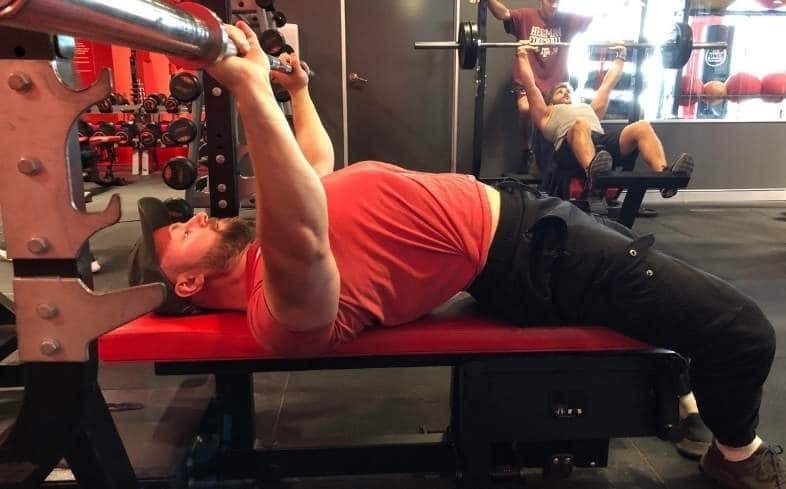Last week the survey showed interest in bench press and warm-up activities, so that’s what we’re focusing on below. If you want to see something specific, please let us know in the survey comments.
This Week’s Resources
Answered: Does a Strong Back Help Bench Press?
Partner Offer
Partners like these help us keep the Powerlifting Technique newsletter free.
Personalized ED treatments, straight to your door.
Hims has helped thousands of men get support for ED, and they’re ready to support you with custom solutions made with clinically proven ingredients.
Does a Strong Back Help Bench Press?
You’re right to think of the bench press as a chest/triceps/shoulders exercise first, because it is. And if your bench is struggling, you’re far more likely to find improvement while working on those three muscle groups.
Yes, a strong back helps your bench press because your back muscles provide stability to your bench press. It helps you confidently lower the barbell to your chest as well as to retract your shoulders and scapula (shoulder blades) to get into and maintain an ideal bench press arch.
But your back is involved in the bench press in two major ways: getting into position and in the descent, or eccentric portion, of the lift when you lower the bar to your chest.
When you get into the bench press arch position, you should be retracting your scapula.
To do that, you use you a combination of your rhomboids (the muscles in the middle of your upper back), trapezius (the muscles along the back of your neck and shoulders), and latissimus dorsi (the flat, wide muscle along the side of your mid and lower back).
You can visualize this by shrugging your shoulders up, then pulling them back by squeezing your shoulder blades together, and then finally pushing your shoulder blades downward.
This is the position you should hold while benching.
Does Dumbbell Bench Press Help Your Barbell Bench Press?
There are six ways dumbbell bench improves bench press for powerlifters. We cover all of them in our article on the subject. Here are two we wanted to highlight.
Increased Range of Motion
Think of your barbell bench press. How low can you get the bar? The answer is easy – you can get it to your chest and no lower than that.
When you train with dumbbells instead of the barbell, there’s nothing to hit your chest, allowing you to train a lower range of motion.
This is a perfect example of how the dumbbell bench press is very similar to the barbell bench press but has its own unique benefits that you just can’t replicate with the barbell version without a specialized bench press bar.
Unilateral Strength
If you ever experience the “airplane” bench press where the bar is very slanted due to one side moving up faster than the other, it’s a sign that you have a strength imbalance.
In plain terms, one side of your body is stronger than the other, which causes you to have an uneven bench press.
The dumbbell bench press is a great way to remedy that, as each arm has its own load to press. There’s no way for your weaker arm to rely on the stronger one to do more of the work or keep momentum going while it tries to keep up.
This benefit is true with most unilateral (one-sided) exercises, so they’re a great staple to include in any program.
“The dumbbell bench press helps the barbell bench press because they are similar pressing movements and because it introduces a unique stimulus through an increased range of motion.”
Finding this newsletter helpful? Please share it on social media.
And we’re always interested in what you want to read next. Here’s a quick survey to let us know what you need.
What do you need help with?
Want to share your own success story? Leave a comment when you fill out your form. We may publish your quote in an upcoming newsletter.
2 Common Mistakes People Make with Incline Bench
Two common mistakes with the incline press are not being prepared for the added ROM and not touching your chest at all.
I see this all the time with lifters switching over to the incline press after doing a lot of flat bench or decline bench. The added ROM feels hard and unfamiliar, so these lifters get nervous and press the barbell back up once it gets to their nose or chin.
Sure, you’re still working some muscles, but why do an incline bench if you’re skipping the part the incline bench specifically exaggerates and emphasizes for your benefit?
Use a lighter weight than you think you can do to get familiar with the movement. Warm it up from an empty barbell and work your way up, so you are comfortable bringing the barbell all the way to your chest and pressing it back up again.
Courses and Coaches
Looking for a serious performance boost? Take an on-demand powerlifting course or reach out to one of our coaches for one-on-one guidance.
If you’re looking for live feedback, reach out to one of our coaches. Most are happy to chat with a consultation call.




